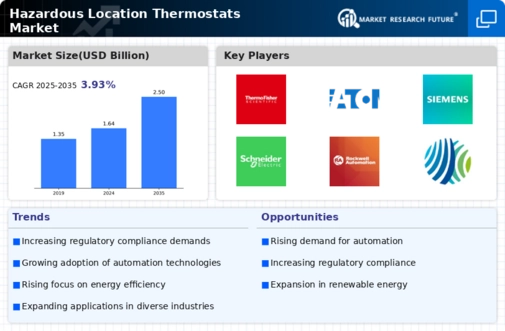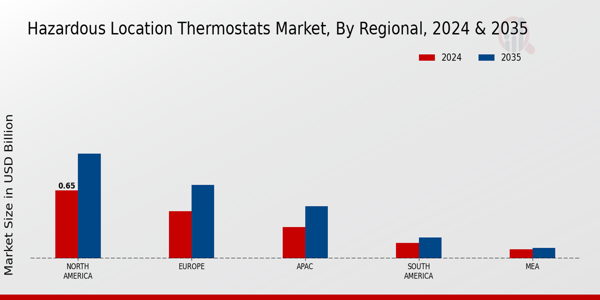Market Growth Projections
The Global Hazardous Location Thermostats Market Industry is projected to experience substantial growth in the coming years. With an anticipated market value of 1.64 USD Billion in 2024, the industry is set to expand significantly, reaching an estimated 2.5 USD Billion by 2035. This growth trajectory indicates a compound annual growth rate (CAGR) of 3.91% from 2025 to 2035. Such projections highlight the increasing importance of hazardous location thermostats across various sectors, driven by factors such as regulatory compliance, technological advancements, and the need for enhanced safety measures.
Growth in Oil and Gas Sector
The oil and gas sector is a significant driver of the Global Hazardous Location Thermostats Market Industry. As exploration and production activities expand in remote and hazardous locations, the demand for reliable thermostatic solutions increases. These thermostats are crucial for maintaining optimal operating conditions in environments where flammable gases and liquids are present. For instance, offshore drilling platforms require robust temperature control systems to ensure safety and efficiency. The continued investment in oil and gas infrastructure, particularly in emerging markets, is likely to bolster the market, as companies seek to comply with safety regulations while optimizing production processes.
Expansion of Chemical Manufacturing
The expansion of the chemical manufacturing sector is a notable driver for the Global Hazardous Location Thermostats Market Industry. As chemical production facilities grow, the need for effective temperature control systems becomes paramount to prevent hazardous incidents. These facilities often operate under extreme conditions, necessitating thermostats that can withstand corrosive environments. The increasing production of specialty chemicals and the rise of new chemical plants in developing regions further amplify this demand. Consequently, manufacturers are focusing on developing thermostats that meet the specific requirements of the chemical industry, ensuring safety and compliance with regulatory standards.
Rising Demand for Energy Efficiency
Energy efficiency is becoming a critical focus for industries worldwide, influencing the Global Hazardous Location Thermostats Market Industry. Companies are increasingly seeking thermostatic solutions that not only ensure safety but also contribute to energy conservation. Advanced thermostats can optimize heating and cooling processes, reducing energy consumption and operational costs. For example, industries that implement energy-efficient thermostats report significant reductions in energy bills, which can be a compelling incentive for adoption. As sustainability becomes a priority, the market is poised for growth, with businesses recognizing the dual benefits of safety and energy efficiency.
Increasing Industrial Safety Regulations
The Global Hazardous Location Thermostats Market Industry is experiencing growth due to the rising emphasis on industrial safety regulations. Governments worldwide are implementing stringent safety standards to mitigate risks associated with hazardous environments. For instance, the Occupational Safety and Health Administration (OSHA) in the United States mandates specific safety measures for workplaces dealing with flammable materials. This regulatory landscape compels industries to adopt advanced thermostatic solutions that can withstand extreme conditions, thereby driving demand for hazardous location thermostats. As a result, the market is projected to reach 1.64 USD Billion in 2024, reflecting the industry's commitment to enhancing safety protocols.
Technological Advancements in Thermostat Design
Technological innovation plays a pivotal role in the Global Hazardous Location Thermostats Market Industry. Manufacturers are increasingly integrating smart technologies into thermostat designs, enabling remote monitoring and control capabilities. These advancements not only enhance operational efficiency but also improve safety by allowing real-time data analysis and alerts for temperature fluctuations. For example, the incorporation of IoT technology allows for seamless integration with existing systems, providing users with comprehensive insights into environmental conditions. As industries continue to embrace these innovations, the market is expected to grow at a CAGR of 3.91% from 2025 to 2035, reaching an estimated 2.5 USD Billion by 2035.











